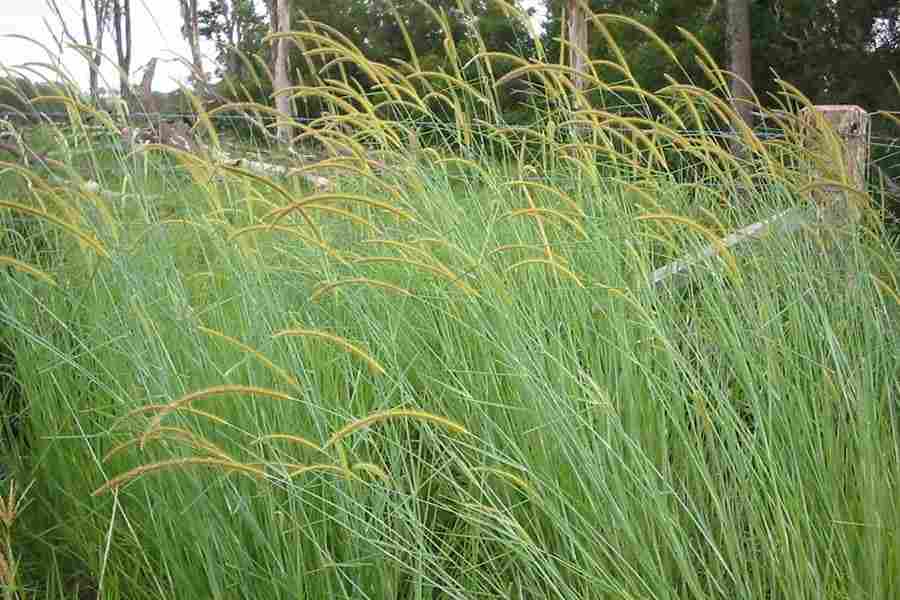Setaria (Setaria sphacelata)

Setaria (Setaria sphacelata) is a densely tufted perennial grass that is widely distributed in Kenya. It originated from Nandi in 1935. There are three varieties, i.e. Nandi setaria, Narok setaria and Kazungula.
It grows to a height of 2m and has short rhizomes and noded stolons. The leaves are long and narrow without hairs. The leaf sheaths are firm and leaf blades have long narrow and parallel veins having a characteristic tapering pointed ends. The plant forms a broad base and provide sufficient cover in a uniform sod.
The grass is readily established from seeds. It can persist well when moderate grazing is practiced where rainfall is between 1500 and 2900mm annually.
The grass becomes coarse and stemmy if not properly managed. It als forms stemmy structures on the onset of dry periods even under good management. It can tolerate little frost and water logging. Young seedlings have deep bluish green leaves which arise from black purple tinged basal shoot.
Under fertile and good moisture conditions leaves can grow to 50cm in length and this signifies maturity of the grass. Once this stage is reached tall stems appear from the central position of the plant. Seed head emerges which are long, cylindrical in shape and densely packed. Growth, maturity and flowering are not uniform between the plants. Once properly established, setaria are more persistent than Rhodes grass and therefore forms very good grazing areas if properly managed.
The herbage is of good quality if the grass is grown in moderate to high fertile soil and this drops in low quality soil. Soils should therefore be fertile, in good rainfall and careful grazing management to eliminate the coarse material that occurs under bad management.
The dry matter (DM) production is high at 8 – 10 ton/ha/yr if mowed at intervals of 8 weeks. Seeding rate is at 4 – 6 Kg/ha. The seeds are small therefore should not be planted too deep.
Cultivation
| Climate | It can grow in a wide range of areas but is more common in medium to high altitude areas with rainfall ranging from 700 to 2000 mm per year. |
| Soil | Will grow under a wide range of soil conditions but does best on sandy or loamy soils of good fertility. It withstands water logging. |
| Site | Setaria can be grown in cut-and-carry as well as grazed plots. It can also be grown in strips along contours for soil erosion control. |
| Preparation | Prepare a fne seedbed by ploughing and harrowing at least once. Harrow after the weeds have emerged to reduce competition during establishment. Sow immediately after harrowing. |
| Planting | Plant early to middle of the rainy season. Where there are two rainy seasons, it is best to plant during the short rainy season. Setaria can be established from seed, splits or rooted cuttings but is best estab lished from seed. Sow seed when the soil is loose (dry). Make furrows 25 cm apart using a peg. Drill the seeds in the furrows no deeper than 2 cm, using a seed rate of about 12 kg per hectare. Cover the seeds lightly by pulling light tree branches over the furrows. If using splits or cuttings, plant on ridges, using a spacing of 20 cm between plants and 50 cm between rows. |
| Fertilizer |
If manure is available, a generous amount should be worked into the soil during seedbed preparation or put into the planting furrows/holes and thoroughly mixed with soil. In addition, apply 125 kg NPK fertilizer per hectare at planting time. After the frst harvest apply 250 kg NPK fertilizer per hectare each year. |
| Weeding | Keep the plot weed-free especially during the initial period of establishment. After the grass is well established, it competes well with weeds. |
| Pests | General pests such as army worm and locusts may pose a threat to setaria but there are no important diseases. |
| Feeding |
Start harvesting or grazing soon after flowering. Initially it should be lightly grazed but once well established, graze heavily to prevent it becoming tough. When cutting, cut to 10 cm from the ground. |



